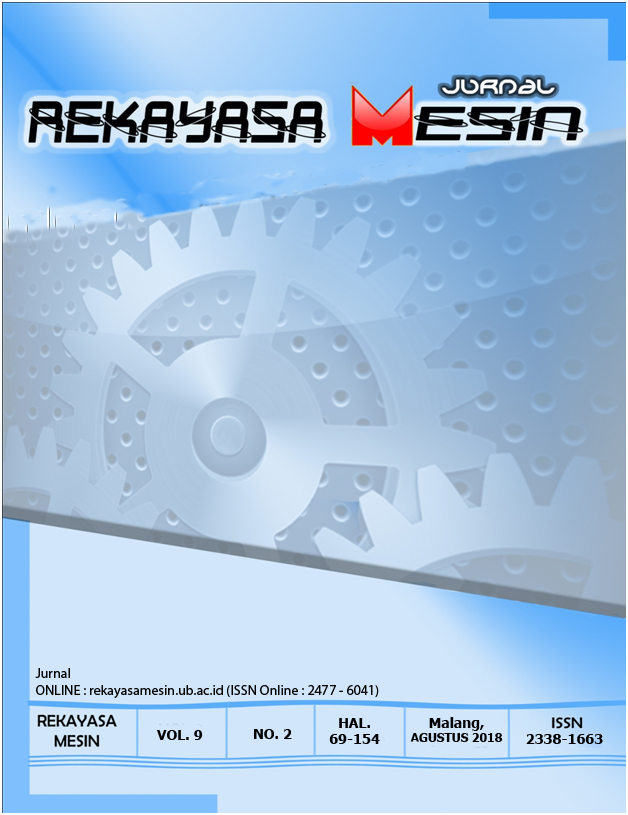Pengaruh Temperatur Karbonisasi terhadap Mikrostruktur dan Pembentukan Kristal pada Biokarbon Eceng Gondok sebagai Bahan Dasar Absorber Gelombang Elektromagnetik Radar
DOI:
https://doi.org/10.21776/ub.jrm.2018.009.02.10Keywords:
Biocarbon, Eichornia Crassipe, Radar Absorbing Material, TemperatureAbstract
Radar Absorbing Materials (RAM) or radar absorbing materials of radar electromagnetic waves are materials used to reduce or eliminate radiation of radar electromagnetic waves in order to avoid reflection of waves. At this time the development of RAM research leads to materials derived from nature. Some materials derived from nature that has been used as RAM such as rice husk, bamboo, coconut shell, coconut husk, wood fiber, and wood flour. In this study, eichornia crassipe is made into biocarbon or activated carbon for use as a base material for RAM. Carbonization is one way to transform water hyacinth into biocarbon or activated carbon. The method used in this research is Experimental Research. The independent variables of this research are carbonization temperature starting from temperature 500oC, 600oC, 700oC, 800oC, 900oC and 1000oC. The results showed that the higher the carbonization temperature, the more open pores will be with 2 μm diameter at 1000oC, and the higher the carbonization temperature than the percentage of carbon crystal formed higher with the value of 14% at temperatures 900oC and 1000oC. The biocarbon structure of eichornia crassipe is crystalline and amorphous making it suitable for use as RAM material.
References
Thomassin, J. M., Jerome, C., Pardoen, T., Bailly, C., Huynen, I., & Detrembleur, C. (2013). Polymer/carbon based composites as electromagnetic interference (EMI) shielding materials. Materials Science and Engineering R: Reports, 74(7), 211–232.
Liu, S., Chen, X., Zhang, A., Yan, K., & Ye, Y. (2014). Electromagnetic Performance of Rice Husk Ash. BioResources, 9, 2328–2340.
Wu, K. H., Ting, T. H., Liu, C. I., Yang, C. C., & Hsu, J. S. (2008). Electromagnetic and microwave absorbing properties of Ni0.5Zn0.5Fe2O4/bamboo charcoal core-shell nanocomposites. Composites Science and Technology, 68(1), 132–139
Suliyanti, M. M., Yudasari, N., Indayaningsih, N., Tresna, W. P., Wahyu, Y., & Hercuadi, A. Y. (2012). Pembuatan rf absorber berbasis karbon lokal untuk aplikasi radar. InSinas, 137–140
Liu, Q., Gu, J., Zhang, W., Miyamoto, Y., Chen, Z., & Zhang, D. (2012). Biomorphic porous graphitic carbon for electromagnetic interference shielding. J. Mater. Chem., 22(39), 21183–21188.
Velev, P. N., Nenkova, S. K., & Kulevski, M. N. (2012). Polymer composites on the basis of lignocellulose containing copper sulfide for electromagnetic wave protection. Bulgarian Chemical Communications, 44(2), 164–171.
Ratnani, R. D. (2005). Proses Pirolisis Eceng Gondok ( Eichhornia Crassipes) Menjadi Karbon Aktif Dengan Bahan Pengaktif Natrium Klorida ( NaCl). Momentum, 1(1), 5–10.
Salamah, S. (2008). Pembuatan Karbon Aktif Dari Kulit Buah Mahoni Dengan Perlakuan Perendaman Larutan Koh. Prosiding Seminar Nasional Teknoin2, (5), 55–59.
Suhartana. (2006). Pemanfaatan Baku Arang Aktif Dan Aplikasinya Untuk Penjernihan Air Sumur Di Desa Belor. Berkala Fisika, 9(3), 151–156.
Haniffudin, N., & Diah, S. (2013). Pengaruh Variasi Temperatur Karbonisasi dan Karbon Aktif Tempurung Kelapa dan Kapasitansi Electric Double Layer Capacitor (EDLC). Jurnal Teknik Pomits, 2(1), F-13-F-17.
Hao, W. (2014). Refining of hydrochars/ hydrothermally carbonized biomass into activated carbons and their applications. Stockholm University.
Basu, P. (2010). Biomass Gasification and Pyrolysis Practical Design and Theory. Oxford: Elsevier Inc.
Pari, G. (2011). Pengaruh Selulosa Terhadap Strukturkarbon Arang Bagian I: Pengaruh Suhu Karbonisasi. Jurnal Penelitian Hasil Hutan, 29(1), 33–45.
Kartika, V., Ratnawulan, & Gusnedi. (2016). Pengaruh Variasi Suhu Karbonisasi Terhadap Mikrostruktur Dan Derajat Kristalinitas Karbon Aktif Kulit Singkong Sebagai Bahan Dasar Gdl (Gas Diffussion Layer). Pillar Of Physics, 7(April), 105–112.
Nasution, Z. A., & Rambe, S. M. (2011). Pengaruh Temperatur Karbonisasi Terhadap Pembentukan Struktur Pori Pada Arang Cangkang Sawit. Jurnal Dinamika Penelitian Industri, 22(2), 100–105.
S, F. R. . T. ., Handoko, E., Soegijono, B., Umiyatin, Linah, & Agustriany, R. (2008). Pengaruh Temperatur Terhadap Pembentukan Pori Pada Arang Bambu. In Prosiding Seminar Nasional Sain dan Teknologi - II (p. V-240-V-245).
Destyorini, F., Suhandi, A., Subhan, A., & Indayaningsih, N. (2010). Pengaruh Suhu Karbonisasi Terhadap Struktur Dan Konduktivitas Listrik Arang Serabut Kelapa. Jurnal Fisika, 10(2), 122–132.
Chung, D. D. L. (2001). Electromagnetic interference shielding effectiveness of carbon materials. Carbon, 39, 279–285.
Downloads
Published
Issue
Section
License

This work is licensed under a Creative Commons Attribution-NonCommercial 4.0 International License.











